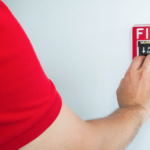Quick Actions To Take When Fire Alarms Malfunction
When a fire alarm goes off, quick thinking matters. But what happens when the alarm starts blaring for no clear reason, or worse, fails to activate when it should? Whether you’re working in a warehouse, on a construction site, or in a small office, a faulty fire alarm can turn a manageable situation into a confusing one. These alarms are there to protect people, so when they stop working the way they’re supposed to, it’s easy to feel caught off guard.
Understanding how to respond calmly can save time and prevent unnecessary panic. Having a few go-to actions in your back pocket helps keep things under control while making sure the safety of your crew isn’t compromised. Fire alarm issues don’t always mean there’s an emergency, but skipping the right steps might put people at risk if there is one.
Knowing what to do in the moment – whether it’s pausing to listen for clues or calling in someone with training – helps everyone involved feel more in control. Not every workplace has a full-time safety officer on site, which is why being able to think fast and follow a steady response checklist is so useful. Let’s explore how you can do that confidently and safely.
Step 1: Don’t Panic and Assess the Situation
The first thing to remember is: don’t panic. It might sound obvious, but staying calm allows you or your team to think clearly and act responsibly. A sudden noise or flash from alarm systems can cause people to scatter or freeze, especially in close spaces or noisy work environments. That’s when confusion can lead to accidents.
Instead of rushing to shut off the system or making guesses about what’s wrong, take a moment to look around. Use your senses:
– Check for visible smoke or flames around doors, vents and ceilings
– Listen for unusual sounds coming from equipment or wiring
– Smell for anything unusual like burning plastic or chemicals
Once you’ve scanned the area and don’t notice any immediate danger, announce what’s happening to others nearby. Keep things simple and calm. Let your team know you’re looking into the alarm and ask them to stay alert and clear of exits just in case. If your protocols include working with a fire warden or supervisor, loop them in straight away.
One example we’ve seen on sites is when dust from grinding equipment triggered a false alarm in a fit-out project. The crew stopped what they were doing, checked the work area, and after confirming there was no fire, followed up with someone trained to reset the system. No shouting, no chaos – just a step-by-step response that kept everyone on track.
Step 2: Silence the Alarm Safely
Once you’re confident there’s no immediate threat, the next step is turning off the alarm properly. If alarms are left ringing too long, people might start ignoring them. That creates a risk during a real emergency. But rushing to turn them off without checking doesn’t help either.
To silence an alarm the right way:
1. Make sure your site policies allow authorised staff to access the control panel.
2. Use the correct passcode or key to disable the alarm. Never force any buttons or wires.
3. Follow your manual or system guide before resetting the system entirely.
4. Make a note of the exact time and location where the fault happened.
Doing this quietly and carefully restores calm and helps document what happened. It’s important that fire safety procedures are followed, especially if your system is connected to emergency services or building management. Some alarms can’t be reset until they’ve been checked over by a technician.
If you’re not sure how to shut it down or can’t access the control panel, don’t take a chance. It’s better to reach out to someone authorised instead of risking further damage. Having that person’s contact saved somewhere easy to find helps those situations get solved quicker.
Step 3: Investigate the Cause of the Malfunction
Once the alarm is off and there’s no sign of actual danger, you can turn your attention to figuring out what caused the problem. Sometimes it’s basic – maybe a low battery or a buildup of dust in the detector. Other times, it could be a fault in the wiring or installation. Taking a moment to investigate sets the stage for preventing future disruptions.
Use this checklist to assess the issue:
– Look for visible signs of damage to the alarm or the nearby wiring
– Check for dust, debris or insects near the sensor or in the casing
– Ask whether anyone on site may have tested or accidentally triggered the system
– Note whether the same sensor or zone has been going off repeatedly
– Confirm whether backup batteries were recently replaced
Even if it only happened once, it’s worth inspecting to make sure there’s nothing bigger going on. False alarms that go unattended often lead to complacency. When people stop reacting because they “know it’s a false one,” the risk gets even higher during a real emergency.
For example, a crew working in an office fit-out recently found that ongoing ceiling works had stirred up insulation, setting off the alarms. It wasn’t immediately obvious, and by the time the third alarm went off, productivity had taken a hit. Once they realised what was causing it, they worked with maintenance to do regular cleaning checks and keep the area safe.
Step 4: Call for Professional Assistance
Some issues are just beyond what can or should be resolved internally. If the alarm keeps going off, won’t reset, or hasn’t been serviced in a long time, the best option is to call in experienced technicians. These professionals can test and repair the system properly, without guesswork.
Get support when:
– Alarms keep sounding without a clear reason, even after being silenced
– You spot exposed wires, water damage or scorch marks near the alarm
– You try following reset instructions but they don’t work
– The system hasn’t been checked by a technician in over a year
– New construction or layout changes may have affected alarm placement
Qualified electricians, fire safety inspectors or alarm specialists have the right tools and experience to identify deeper faults and patch the system in a way that meets compliance. Make sure someone on site is ready to assist them and has access to relevant documents or plans.
Having a trusted expert or contractor on-call can help reduce downtime during these situations. Once the technician finishes their work, it’s smart to document it – note what was done, when, and by whom, so you can track whether similar faults occur again later. It streamlines the response next time around.
Stay Prepared with First Response Fire Training
Fire alarm issues can come out of nowhere, especially in busy or high-risk work environments. What helps most isn’t the alarm system itself, but how well the people around it know how to act. Quick thinking backed by real training makes a huge difference.
Team members with first response fire training know when to stop operations, when to evacuate, and when it’s safe to troubleshoot. They understand how systems work and what common faults look like. This is particularly helpful across Perth worksites, where seasonal changes and equipment use can lead to various fire risks.
Well-prepared teams don’t freeze in the moment. They move with purpose. They communicate clearly. They avoid panic and focus on keeping the group safe. When they’ve had time to practice drills and attend hands-on sessions, those skills stick.
Fire drills and safety sessions aren’t just for ticking off compliance boxes. They help build awareness, speed, and confidence. Over time, they turn each crew member into someone others can count on when things go sideways. Whether it’s a false alarm or the real thing, that sense of readiness matters.
Equip your team for any unexpected fire emergencies with Access Unlimited’s expert guidance. Investing in first response fire training gives your crew the skills to act fast and keep things under control when it matters most. Build confidence on site with hands-on learning designed around your real work conditions.



